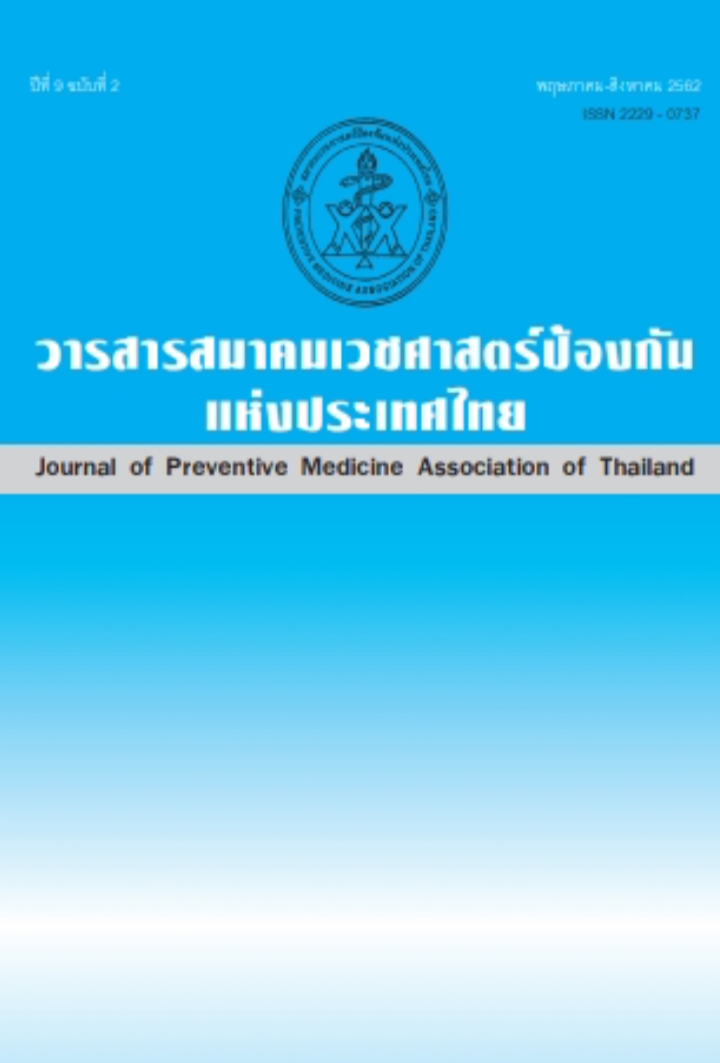A Study of the Result from Palliative Care Program in Terminal Stage Patients, Bangpahan Hospital, Phra Nakhon Si Ayutthaya Province.
Keywords:
palliative care, terminal stage patientAbstract
In this study, the results of palliative care program in terminal stage patients of Bangpahan Hospital were investigated by using descriptive retro-cohort design. The purposive sampling of 32 patients (20 males & 12 females) with terminal illness, whose Palliative Performance scale was ≤50%, was conducted from 2016, September 1st to 2018 February 28th in the palliative care clinic. The studied population was followed up from patient’s registration until death. Based on the results, we found that the mean age of the sampled population was 64.5 13.7 years. The majority of the studied subjects were advanced stage cancer patients 87.5% (liver cancer 18.8%, lung cancer 12.5%, nasopharyngeal cancer 9.4%, cholangiocarcinoma 6.3%, pancreatic cancer 6.3%, esophageal cancer 6.3%, brain cancer 6.3%, breast cancer 6.3%, cervical cancer 3.1%, ovarian cancer 3.1%, colon cancer 3.1%, pyriform cancer 3.1% and Non-Hodgkin’s lymphoma 3.1%), while only 12.5% were found to be non-cancer patients. The initial symptoms that led to the treatment in palliative program were fatigue (Mdn=7.5, IQR=5-8), anorexia (Mdn=6.5, IQR=4-8), pain (Mdn=6, IQR=3-8.8), dyspnea (Mdn=5, IQR=1.3-7.8), drowsiness (Mdn=4, IQR=1-5), and nausea (Mdn=2, IQR=0-4), respectively. After receiving interventions from the palliative care program, the post-treatment follow-up revealed significantly decreased severity of symptoms, including fatigue, pain, anorexia, dyspnea, and nausea (p<0.05). Thirty-one patients (96.9%) died peacefully according to their advance care plans, while only one patient (3.1%) experienced unexpected death. Hopefully, this research might be useful for end-stage care because the treatment procedure could significantly alleviate sufferings from the aforementioned symptoms and allow patients to conceivably die based on the self-caring plan.
References
2. สายพิณ หัตถีรัตน์. เอกสารประกอบการสอนเรื่อง การดูแลปัญหาสุขภาพครอบครัวที่มีสมาชิกใกล้ตาย (Working with the dying). กรุงเทพฯ: ภาควิชาเวชศาสตร์ครอบครัว คณะแพทยศาสตร์โรงพยาบาลรามาธิบดี; ม.ป.ป.
3. ห้องสิน ตระกูลทิวากร. Quality end of life care. อนุสารมีดี 2550;7: หน้า 1-5.
4. ดาริน จตุรภัทรพร. วิธีการประเมินความสามารถในการช่วยเหลือตัวเองของผู้ป่วยโดยใช้ Palliative Performance Scale (PPS) ภาควิชาเวชศาสตร์ครอบครัว [อินเตอร์เน็ต]. [เข้าถึงเมื่อ 28 มีนาคม 2561]. เข้าถึงได้จาก: https://med.mahidol.ac.th/fammed/th/postgrad/doctorpalliative3th
5. Chewaskulyong B, Sapinun L, Downing GM, Intaratat P, Lesperance M, Leautrakul S, et, al. Reliability and validity of the Thai translation (Thai PPS Adult Suandok) of the Palliative Performance Scale (PPSv2). Palliative Medicine. 2012 Dec;26(8):1034-41.doi:10.1177/0269216311424633. Epub 2011 Oct 12.
6. Sherry A. Greenberg, PhD.Palliative Performance Scale (PPSv2) version 2. Medical Care of the Dying, Victoria Hospice Society, 2006. 4thed.; p.121.
7. กิตติพล นาควิโรจน์. วิธีการประเมินอาการต่างๆ โดยใช้แบบประเมิน Edmonton Symptom Assessment System (ESAS)| ภาควิชาเวชศาสตร์ครอบครัว [อินเตอร์เน็ต]. [เข้าถึงเมื่อ 16 เมษายน 2561]. เข้าถึงได้จาก: https://med.mahidol.ac.th/fammed/th/postgrad/doctorpalliative2th
8. Chinda M, Jaturapatporn D, Kirshen AJ, Udomsubpayakul U. Reliability and validity of a Thai version of the edmonton symptom assessment scale (ESAS-Thai). Bruera E, MD version 1991.
9. รัตนา พันธ์พานิช. GOOD DEATH การตายที่ดีคืออย่างไร. วารสารแพทยศาสตร์ คณะแพทยศาสตร์ มหาวิทยาลัยเชียงใหม่ 2555;27(3):16.
10. Hanks GW, De Conno F, Cherny N, Hanna M, Kalso E, McQuay HJ, et al. Morphine and alternative opioids in cancer pain: The EAPC recommendations. British Journal of Cancer 2001;84:587-93. doi:10.1054/bjoc.2001.1680.
11. Kikule Ekiria. A good death in Uganda: survey of needs for palliative care for terminally ill people in urban areas. BMJ 2003;327(7408):192-4.
12. Heyland DK, Dodek P, Rocker G, Groll D, Gafni A, Pichora D, et al. What matters most in End of life care: perceptions of seriously ill patients and their family members. Canadian Medical Association Journal 2006;174:627-33.doi:10.1503/cmaj.050626
13. Julia N. The Future of Health and Care of Older People: The Best of Older People. Age Concern England 1996;p.41-44.
14. Klepstad P, Kaasa S, Cherny N, Hanks G, De Conno F. Pain and pain treatments in European palliative care units. A cross sectional survey from the European Association for Palliative Care Research Network. Palliative Medicine 2005;19:477-84. doi:10.1191/0269216305pm1054oa
15. นงค์รักษ์ สัจจานิจการ. ผลการดูแลผู้ป่วยที่เจ็บป่วยด้วยโรคมะเร็งระยะสุดท้ายจากโรงพยาบาลสู่เครือข่ายชุมชน. น่าน: โรงพยาบาลท่าวังผา จังหวัดน่าน; 2555.
16. Richard S. A good death-An important aim for health services and for us all. BMJ Clinical Research; 320(7228):129-130 • 2000 Jan 15. doi: 10.1136/bmj.320.7228.129
Downloads
Published
How to Cite
Issue
Section
License
บทความที่ลงพิมพ์ในวารสารเวชศาสตร์ป้องกันแห่งประเทศไทย ถือเป็นผลงานวิชาการ งานวิจัย วิเคราะห์ วิจารณ์ เป็นความเห็นส่วนตัวของผู้นิพนธ์ กองบรรณาธิการไม่จำเป็นต้องเห็นด้วยเสมอไปและผู้นิพนธ์จะต้องรับผิดชอบต่อบทความของตนเอง






